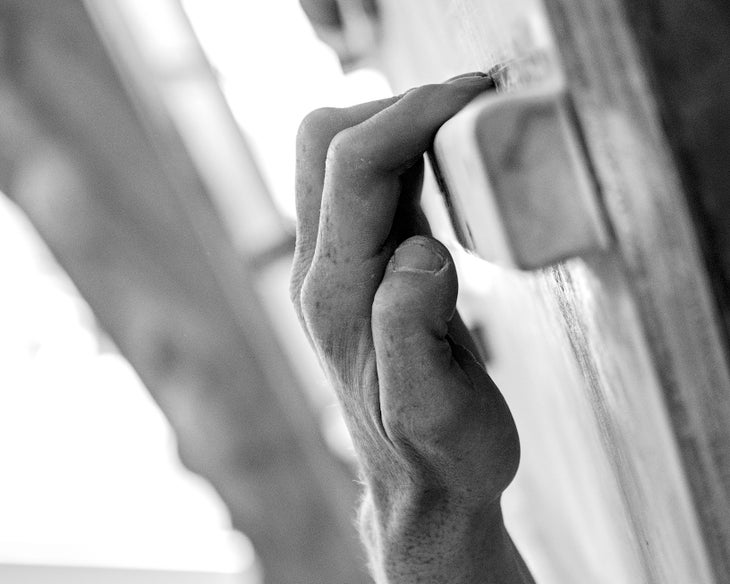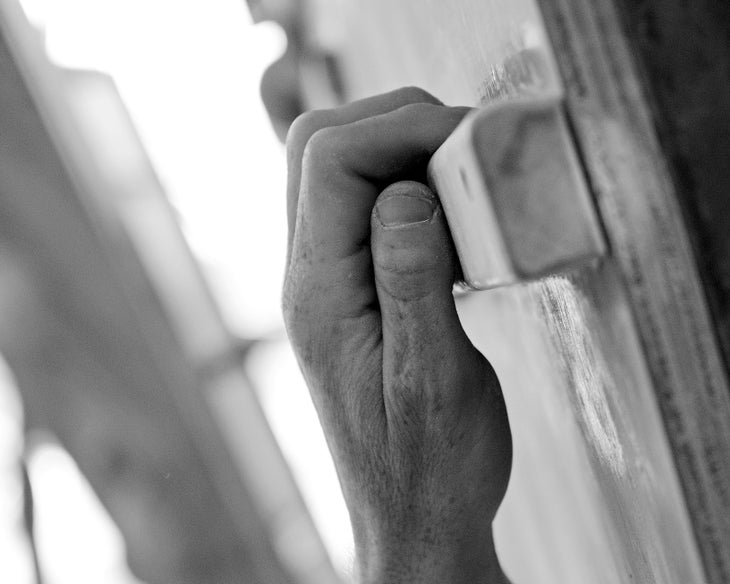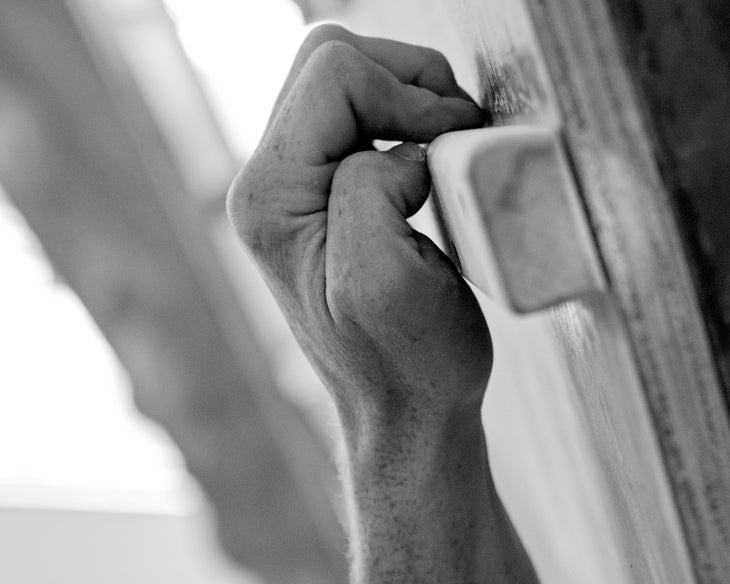Need Stronger Fingers? Do Hangboard Ladders

In climbing, when your fingers fail, the rest of your body falls. Focusing on this direct connection to the rock can benefit your climbing performance greatly, and luckily, finger strength is relatively easy to train. The key with this, like any training, is to do it correctly and in the right amount, as too much can be time-consuming, boring, and possibly harmful. In my 20+ years of training experience, I’ve found a simple way to maximize finger strength while staying far away from the zone where injury is possible. The idea is to strategically change the volume of work in any given session via “hangboard ladders,” where easy, medium, and hard sets are cycled through and weights are adjusted in a way that increases strength while completely avoiding risk.
How Isometric Training Works
The most basic way to get stronger is to work against a load that is “maximal” for just one or two repetitions. Training close to one’s max yields the greatest gains in strength, but there is a major problem: The body can’t take it. Working with maximal loads takes a massive toll on the muscles and nervous system, and it also risks injury to joints and tendons with intense repetition. Moreover, recovering from training with heavy weights can take 72 or more hours, whereas training with a more moderate weight only requires about 24 hours to recover.
This is particularly true in isometric (static) training, where the exercise involves holding a muscle in a static position, like planks, wall sits, or hangboarding. Isometric training simply teaches the muscles to get strong in a fixed range, where the muscle is not significantly lengthening or shortening during the set of work. This is in contrast to more “traditional” modes of training, called isotonic training, that involve concentric and eccentric contractions. Closing the elbow and bringing the weight up in a bicep curl, which shortens the muscle body, is a concentric action. The eccentric action is the opposite, where the muscle is allowed to lengthen under load, or opening the elbow in a bicep curl. Isometric action would simply be holding the elbow in one position, say a 90° bend. Although all three actions are used in most movement, climbers generally hold the fingers in a fixed position once they grab the rock, making isometric training the most useful for finger strengthening.
Several studies on isometric strength have shown that the total volume of load (time hanging) is more important than the degree of load (weight). Using varying percentages of maximum weight and adjusting the total time each athlete worked under load, these studies demonstrated that it matters less how hard the muscles were worked than how long muscles were under tension. In one study, the team showed that seven one-minute contractions at just 30% of maximum resulted in a strength increase of about 30% in just six weeks. Similar studies showed that it’s possible to gain just as much strength at slightly reduced loads (65 to 75% of maximum) as one might gain while training at maximum (more than 90%) effort. Clearly this is the better method for most climbers, as it provides faster recovery between sessions and minimizes injury risk to sensitive fingers.
Finger Positions
One school of thought for hangboard training is that you should always train an open-hand grip, but that doesn’t mimic real-world climbing. Instead, this program focuses on three positions—open hand, half crimp, and full crimp—because they are the most common used in real climbing, and they address the principle of “joint angle specificity.” This principle says that isometric strength is gained only in a small range outside the angle in which it was trained. By covering all three positions, we’re guaranteed to gain strength in any hand position one might encounter on real rock. No matter how disciplined we are about trying to hold an open-hand or half-crimp position, when the going gets tough, the full crimp comes into play. The idea is to train this position carefully in a controlled environment instead of rolling the dice when on the rock.
Open Hand

Second joint is below the level of the first joint on a large edge or sloper; requires least amount of effort.
Half Crimp

Second and first joints are even on a hold; requires moderate effort.
Full Crimp

Second joint is above the first joint, requires most effort.
The Workout
Find an open-hand grip that you can hang onto for 10 to 12 seconds. You can add or reduce weight, but it’s best to start with a hold that you can hang on at bodyweight. For the next four weeks, this will be your training hold, so choose the hold carefully. Using this position, hang for just three seconds.
Rest a while, somewhere between 10 and 60 seconds is fine. The actual time isn’t important. The rule of thumb in strength is this: Long rests lead to great gains in neurological factors such as recruitment and firing rate; shorter rests lean more toward hypertrophy (muscle growth). Stay fresh to get strong. To fight boredom and continue resting, stretch or complete another non-finger exercise.
Follow the rest with a six-second open-hand hang. Rest again, longer if you need to. Follow this rest with another hang, this time nine seconds long. After the nine-second hang, you’ve completed one ladder of 3-6-9. The beginning of the program starts with three sets of 3-6-9 ladders for each hold position. Rest as needed between sets. Repeat this pattern with a full crimp and then finish with the half crimp, also for three sets of 3-6-9. Full crimp is trained second to ensure you’re warmed up for it. We finish with half crimp because it is the strongest position. Execute these moves well, remembering quality over quantity.
Do this session once more during the week. In the second week, increase to four sets per hand position twice a week. In the third week, do five sets per hand position twice a week. In the fourth week, do three sets for each position, but add a 12-second hang so you are doing 3-6-9-12 twice a week.
After completing the fourth week, assess your strength, and then restart the program with slightly increased loads, meaning add some weight to your hangs. Big load jumps aren’t necessary, so add weight conservatively. If you add somewhere around 2 to 5% of your bodyweight each cycle for several cycles, that’s great. The ultimate goal is to continue to progress over the long-term, and adding too much weight too soon will only result in a plateau.
Sample Hangboard Progression
Week 1 (x2)
- Open hand: 3 sets of 3-6-9
- Full crimp: 3 sets of 3-6-9
- Half crimp: 3 sets of 3-6-9
Week 2 (x2)
- Open hand: 4 sets of 3-6-9
- Full crimp: 4 sets of 3-6-9
- Half crimp: 4 sets of 3-6-9
Week 3 (x2)
- Open hand: 5 sets of 3-6-9
- Full crimp: 5 sets of 3-6-9
- Half crimp: 5 sets of 3-6-9
Week 4 (x2)
- Open hand: 3 sets of 3-6-9-12
- Full crimp: 3 sets of 3-6-9-12
- Half crimp: 3 sets of 3-6-9-12
Hangboard Ladders: A Few Rules
The goal of this program is to build strength over a variety of hang times while maintaining a very low risk of injury. Follow these guidelines to maximize your training.
- Don’t get pumped. If you are pumped or sweating, you aren’t resting long enough between hangs.
- Train while climbing hard outside. This is a pure strength program, so it’s appropriate to use at the same time as you are trying to climb well outside. If you are a weekend warrior, this is a great Monday through Thursday plan, and you can do some other climbing.
- Don’t be in a hurry to get strong fast. Quick strength gains lead to quick losses. Slow gains are the ones you keep. Research shows that high-intensity training can lead to quick strength increases, with the gains coming from improvements in energy-system efficiency. On the other hand, a slow, steady progression creates more efficient neurological pathways, which leads to long-term persistent gains.
- Only increase the load once a month. Don’t look at strength training as an event or something to do this month, but as a new lifestyle habit. Your mind should not be on next weekend, but on five years from now.
- This training program can be used year-round. However, many climbers find that training constantly is difficult. For such climbers, try two 4-week cycles, followed by a month of just climbing. After this “month off,” resume the cycle. A good schedule for a weekend warrior would be to train Monday and Thursday or Tuesday and Thursday. The specific days of the week don’t matter, but you should have at least one day between training finger strength so you’re fresh.
Steve Bechtel is a performance coach and writer (climbstrong.com) with more than 300 first ascents across the globe, and he is the founder of Elemental Performance + Fitness.
This story originally appeared in the June 2016 issue of our print edition.
The post Need Stronger Fingers? Do Hangboard Ladders appeared first on Climbing.

